The AMD Ryzen 7 5700G, Ryzen 5 5600G, and Ryzen 3 5300G Review
by Dr. Ian Cutress on August 4, 2021 1:45 PM ESTCPU Tests: Office and Science
Our previous set of ‘office’ benchmarks have often been a mix of science and synthetics, so this time we wanted to keep our office section purely on real-world performance.
Agisoft Photoscan 1.3.3: link
The concept of Photoscan is about translating many 2D images into a 3D model - so the more detailed the images, and the more you have, the better the final 3D model in both spatial accuracy and texturing accuracy. The algorithm has four stages, with some parts of the stages being single-threaded and others multi-threaded, along with some cache/memory dependency in there as well. For some of the more variable threaded workload, features such as Speed Shift and XFR will be able to take advantage of CPU stalls or downtime, giving sizeable speedups on newer microarchitectures.
For the update to version 1.3.3, the Agisoft software now supports command line operation. Agisoft provided us with a set of new images for this version of the test, and a python script to run it. We’ve modified the script slightly by changing some quality settings for the sake of the benchmark suite length, as well as adjusting how the final timing data is recorded. The python script dumps the results file in the format of our choosing. For our test we obtain the time for each stage of the benchmark, as well as the overall time.
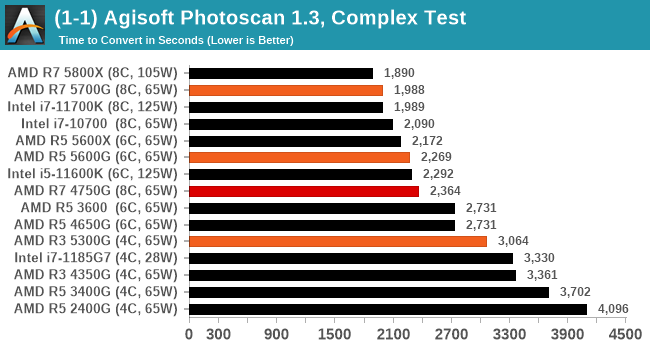
Photoscan shows good gen-on-gen performance uplifts, with the 5700G on par with the 11700K despite being lower powered. Both the R7 and R5 APUs are within touching distance of their X counterparts, and we see a good performance jump from the 4000G series.
Application Opening: GIMP 2.10.18
First up is a test using a monstrous multi-layered xcf file to load GIMP. While the file is only a single ‘image’, it has so many high-quality layers embedded it was taking north of 15 seconds to open and to gain control on the mid-range notebook I was using at the time.
What we test here is the first run - normally on the first time a user loads the GIMP package from a fresh install, the system has to configure a few dozen files that remain optimized on subsequent opening. For our test we delete those configured optimized files in order to force a ‘fresh load’ each time the software in run. As it turns out, GIMP does optimizations for every CPU thread in the system, which requires that higher thread-count processors take a lot longer to run.
We measure the time taken from calling the software to be opened, and until the software hands itself back over to the OS for user control. The test is repeated for a minimum of ten minutes or at least 15 loops, whichever comes first, with the first three results discarded.

GIMP is a funny test where it gets harder the more cores you have - that's why the quad cores win here. However slow quad cores (like the 2400G still let you down. There seems to be minor gains here for the R5000 series with Zen 3 under the hood.
Science
In this version of our test suite, all the science focused tests that aren’t ‘simulation’ work are now in our science section. This includes Brownian Motion, calculating digits of Pi, molecular dynamics, and for the first time, we’re trialing an artificial intelligence benchmark, both inference and training, that works under Windows using python and TensorFlow. Where possible these benchmarks have been optimized with the latest in vector instructions, except for the AI test – we were told that while it uses Intel’s Math Kernel Libraries, they’re optimized more for Linux than for Windows, and so it gives an interesting result when unoptimized software is used.
3D Particle Movement v2.1: Non-AVX and AVX2/AVX512
This is the latest version of this benchmark designed to simulate semi-optimized scientific algorithms taken directly from my doctorate thesis. This involves randomly moving particles in a 3D space using a set of algorithms that define random movement. Version 2.1 improves over 2.0 by passing the main particle structs by reference rather than by value, and decreasing the amount of double->float->double recasts the compiler was adding in.
The initial version of v2.1 is a custom C++ binary of my own code, and flags are in place to allow for multiple loops of the code with a custom benchmark length. By default this version runs six times and outputs the average score to the console, which we capture with a redirection operator that writes to file.
For v2.1, we also have a fully optimized AVX2/AVX512 version, which uses intrinsics to get the best performance out of the software. This was done by a former Intel AVX-512 engineer who now works elsewhere. According to Jim Keller, there are only a couple dozen or so people who understand how to extract the best performance out of a CPU, and this guy is one of them. To keep things honest, AMD also has a copy of the code, but has not proposed any changes.
The 3DPM test is set to output millions of movements per second, rather than time to complete a fixed number of movements.
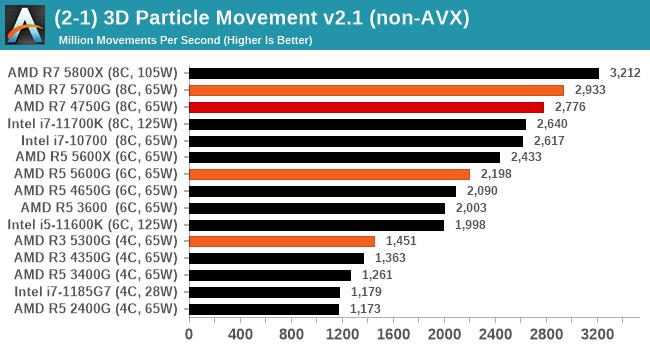
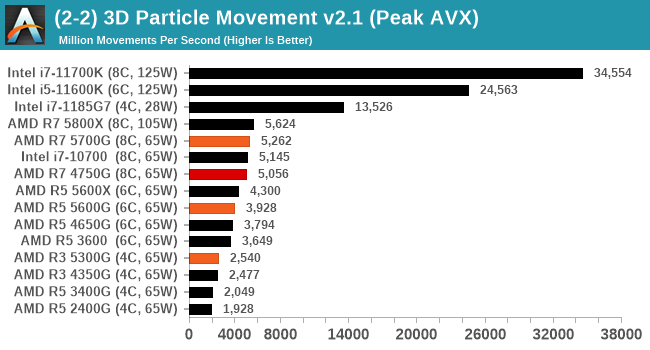
Ignoring the Peak AVX results which are heavily weighted in favor of AVX-512 enabled CPUs, with the non-AVX code we're seeing about a 5% performance gain on R5000G over R4000G.
y-Cruncher 0.78.9506: www.numberworld.org/y-cruncher
If you ask anyone what sort of computer holds the world record for calculating the most digits of pi, I can guarantee that a good portion of those answers might point to some colossus super computer built into a mountain by a super-villain. Fortunately nothing could be further from the truth – the computer with the record is a quad socket Ivy Bridge server with 300 TB of storage. The software that was run to get that was y-cruncher.
Built by Alex Yee over the last part of a decade and some more, y-Cruncher is the software of choice for calculating billions and trillions of digits of the most popular mathematical constants. The software has held the world record for Pi since August 2010, and has broken the record a total of 7 times since. It also holds records for e, the Golden Ratio, and others. According to Alex, the program runs around 500,000 lines of code, and he has multiple binaries each optimized for different families of processors, such as Zen, Ice Lake, Sky Lake, all the way back to Nehalem, using the latest SSE/AVX2/AVX512 instructions where they fit in, and then further optimized for how each core is built.
For our purposes, we’re calculating Pi, as it is more compute bound than memory bound. In single thread mode we calculate 250 million digits, while in multithreaded mode we go for 2.5 billion digits. That 2.5 billion digit value requires ~12 GB of DRAM, and so is limited to systems with at least 16 GB.
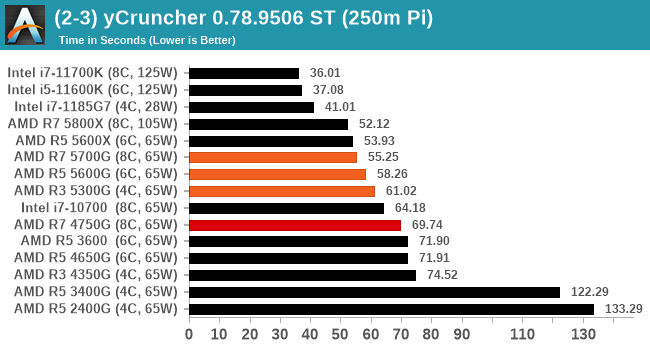
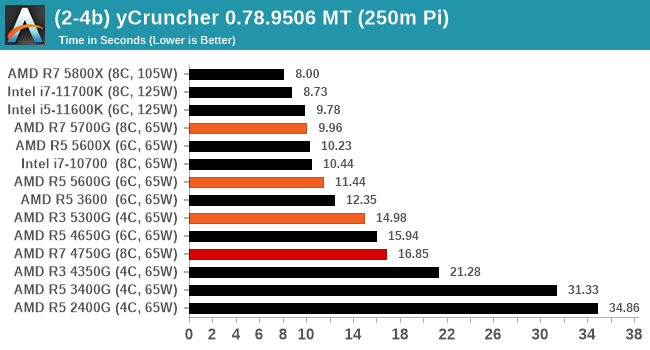
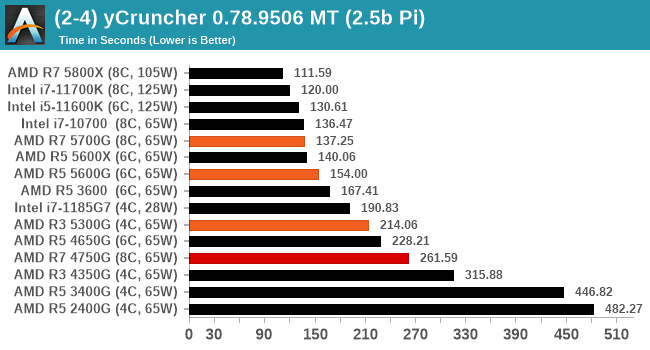
The R3 5300G is crushing the R4000 series here, which is likely down to the unified L3 cache strcuture.
NAMD 2.13 (ApoA1): Molecular Dynamics
One of the popular science fields is modeling the dynamics of proteins. By looking at how the energy of active sites within a large protein structure over time, scientists behind the research can calculate required activation energies for potential interactions. This becomes very important in drug discovery. Molecular dynamics also plays a large role in protein folding, and in understanding what happens when proteins misfold, and what can be done to prevent it. Two of the most popular molecular dynamics packages in use today are NAMD and GROMACS.
NAMD, or Nanoscale Molecular Dynamics, has already been used in extensive Coronavirus research on the Frontier supercomputer. Typical simulations using the package are measured in how many nanoseconds per day can be calculated with the given hardware, and the ApoA1 protein (92,224 atoms) has been the standard model for molecular dynamics simulation.
Luckily the compute can home in on a typical ‘nanoseconds-per-day’ rate after only 60 seconds of simulation, however we stretch that out to 10 minutes to take a more sustained value, as by that time most turbo limits should be surpassed. The simulation itself works with 2 femtosecond timesteps. We use version 2.13 as this was the recommended version at the time of integrating this benchmark into our suite. The latest nightly builds we’re aware have started to enable support for AVX-512, however due to consistency in our benchmark suite, we are retaining with 2.13. Other software that we test with has AVX-512 acceleration.
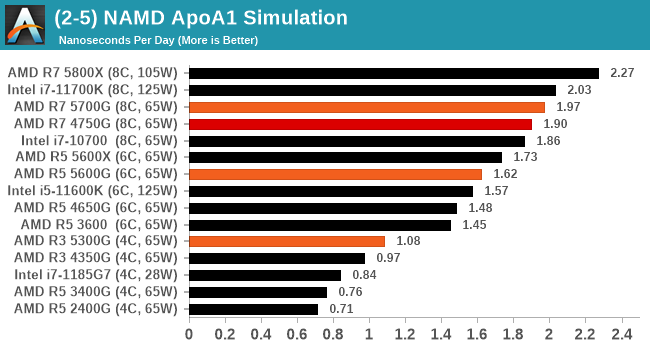
The slower 5000G processors are +10% faster generationally, while the R7 is about 4% faster. They all sit behind the desktop counterparts though.
AI Benchmark 0.1.2 using TensorFlow: Link
Finding an appropriate artificial intelligence benchmark for Windows has been a holy grail of mine for quite a while. The problem is that AI is such a fast moving, fast paced word that whatever I compute this quarter will no longer be relevant in the next, and one of the key metrics in this benchmarking suite is being able to keep data over a long period of time. We’ve had AI benchmarks on smartphones for a while, given that smartphones are a better target for AI workloads, but it also makes some sense that everything on PC is geared towards Linux as well.
Thankfully however, the good folks over at ETH Zurich in Switzerland have converted their smartphone AI benchmark into something that’s useable in Windows. It uses TensorFlow, and for our benchmark purposes we’ve locked our testing down to TensorFlow 2.10, AI Benchmark 0.1.2, while using Python 3.7.6.
The benchmark runs through 19 different networks including MobileNet-V2, ResNet-V2, VGG-19 Super-Res, NVIDIA-SPADE, PSPNet, DeepLab, Pixel-RNN, and GNMT-Translation. All the tests probe both the inference and the training at various input sizes and batch sizes, except the translation that only does inference. It measures the time taken to do a given amount of work, and spits out a value at the end.
There is one big caveat for all of this, however. Speaking with the folks over at ETH, they use Intel’s Math Kernel Libraries (MKL) for Windows, and they’re seeing some incredible drawbacks. I was told that MKL for Windows doesn’t play well with multiple threads, and as a result any Windows results are going to perform a lot worse than Linux results. On top of that, after a given number of threads (~16), MKL kind of gives up and performance drops of quite substantially.
So why test it at all? Firstly, because we need an AI benchmark, and a bad one is still better than not having one at all. Secondly, if MKL on Windows is the problem, then by publicizing the test, it might just put a boot somewhere for MKL to get fixed. To that end, we’ll stay with the benchmark as long as it remains feasible.
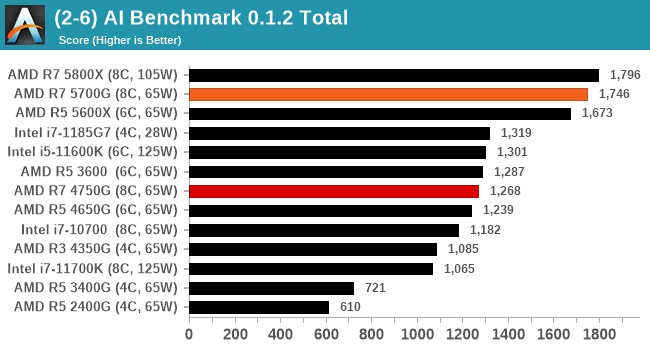


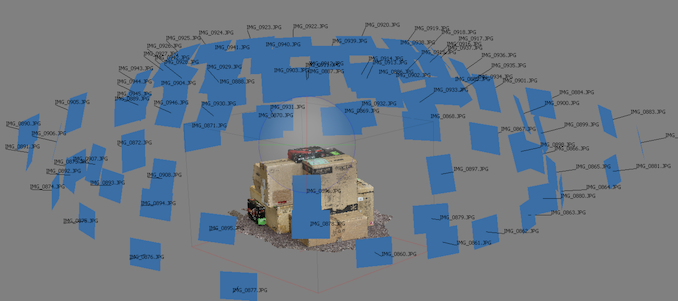

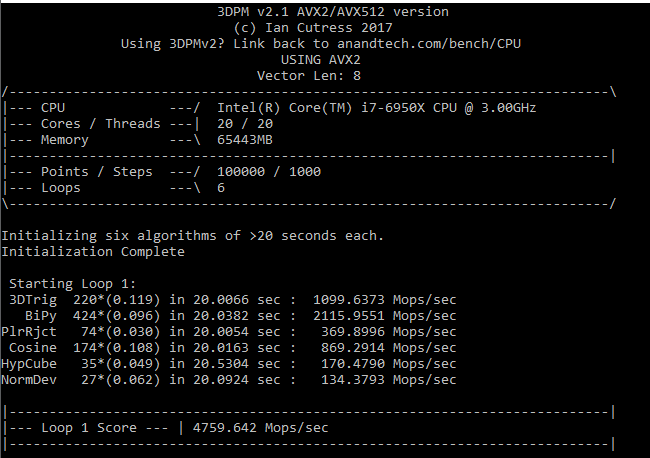
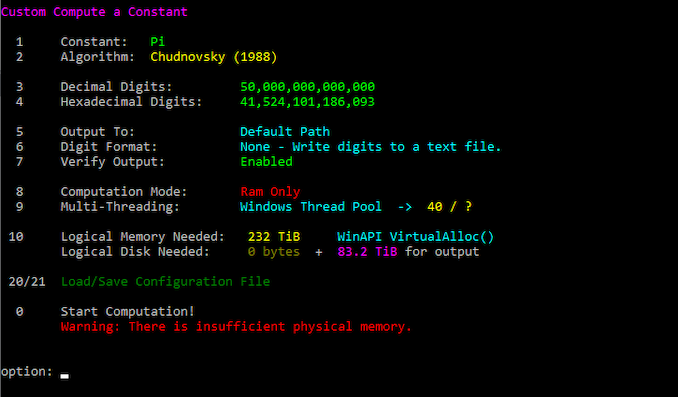










135 Comments
View All Comments
Wereweeb - Wednesday, August 4, 2021 - link
The bottleneck is memory bandwidth. DDR5 will raise the iGPU performance roof by a substantial amount, but I hope for something like quad-channel OMI-esque Serial RAM.abufrejoval - Saturday, August 7, 2021 - link
I'd say so, too, but...I have just had a look at a Kaveri A10-7850K with DDR3-2400 (100 Watt desktop), a 5800U based notebook with LPDDR4 (1333MHz clock) and a Tiger Lake NUC with an i7-1165G7 with DDR4-3200.
The memory bandwidth differences between the Kaveri and the 5800U is absolutely minor, 38.4 GB/s for the Kaveri vs. 42.7GB/s for Cezanne (can't get the TigerLake figures right now, because it's running a Linux server, but it will be very similar).
The Kaveri and Cezanne iGPUs are both 512 shaders and apart from architectural improvements very much differ in clocks 720MHz vs. 2000MHz. The graphics performance difference on things like 3DMark scale pretty exactly with that clock difference.
Yet when Kaveri was launched, Anandtech noted that the 512 shader A10 variant had trouble to do better then the 384 shader APUs, because only with the very fastest RAM it could make these extra shaders pump out extra FPS.
When I compared the Cezanne iGPU against the TigerLake X2, both systems at tightly fixed 15 and 28Watts max power settings, TigerLake was around 50% faster on all synthetic GPU benchmarks.
The only explanation I have for these fantastic performance increases is much larger caches being very smartly used by breaking down GPU workloads to just fit within them, while prefetching the next tile of bitmaps into the cache in the background and likewise pushing processed tiles to the framebuffer RAM asynchronously to avoid stalling GPU pipelines.
And yet I'd agree that there really isn't much wiggling room left, you need exponential bandwidth to cover square resolution increases.
abufrejoval - Saturday, August 7, 2021 - link
need edit!Is TigerLake Xe, not X2.
Another data point:
I also have an NUC8 with an 48EU (+128MB eDRAM) Iris 655 i7 and a NUC10 with an 24EU "no Iris" UHD i7. Even with twice the EUs and the extra eDRAM (which I believe can be used in parallel to the external DRAM), the Iris only gets a 50% performance increase.
The the 96EU TigerLake iGPU is doing so much better (better than linear scale over UHD) while it actually has somewhat less bandwidth (and higher latency) than the 50GB/s eDRAM provides for the 48EU Iris.
bwj - Wednesday, August 4, 2021 - link
Why are these parts getting stomped by Intel and their non-graphics Ryzen siblings?bwj - Wednesday, August 4, 2021 - link
Meh, meant to say "in browser benchmarks". Browser is an important workload (for me at least) and the x86 crowd is already fairly weak versus Apple M1, so I'm not ready to throw away another 30% of browser perf.Lezmaka - Wednesday, August 4, 2021 - link
There are only 3 browser tests and for two of them the 5700G is within a few percent of the 11700K. But otherwise, it's because these are laptop chips with higher TDP. The 11700K has a TDP of "125W" but hit 277W where the 5700G has a TDP of 65W and maxed out at 88W.Makaveli - Wednesday, August 4, 2021 - link
There is something up with the browser scores here anyways compared to what you see in the forum. All the post with similar desktop cpu's in that thread post much high scores than what is listed in the graph. I'm not sure its old browser version being used to keep scores inline with older reviews or something.https://forums.anandtech.com/threads/how-fast-is-y...
abufrejoval - Wednesday, August 4, 2021 - link
When you ask: "Why don't they release the four core variant?" you really should be able to answer that yourself!There are simply not enough defective chips to make it viable just yet. Eventually they may accumulate, but as long as they are trying to produce an 8 core chip, 4 and 6 cores should remain the exception not the rule.
I'd really like to see them struggle putting the lesser chips out there, because it means my 8/16(/32/64) core chips are rock solid!
I would have liked to see full transistor counts of the 5800X and the 5700U side by side. My guess would be that the Cezanne dies even at 50% cache have more transistors overall, meaning you are getting many more pricey 7nm transistors per € on these APUs and should really pay a markup not a discount.
Well even the GF IO die fab capacity might have customers lined up these days, but in normal times those transistors should be much more commodity and cheaper and have the APU cost more in pure foundry (less in packaging) than the X-variants, while AMD wants to fit it into a below premium price slot where it really doesn't belong.
nandnandnand - Wednesday, August 4, 2021 - link
If AMD boosted chiplet/monolithic core count to 12, maybe 6 cores could become the new minimum with 10-core being a possibility. But it doesn't look like they plan to do that.Wereweeb - Wednesday, August 4, 2021 - link
These might have been a stockpile of dies that were rejected for laptop use (High power consumption @ idle?) and they're being dumped into the market after AMD satisfied OEM demand for APU's.Plus, considering that one of the main shortages is for substrates, it's possible that the substrate for the APU's is different - cheaper, higher volume, etc... as it doesn't need to interconnect discrete chiplets.